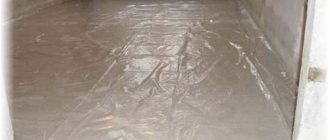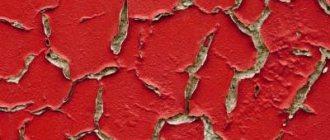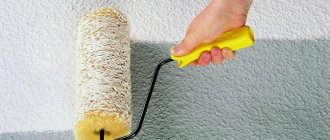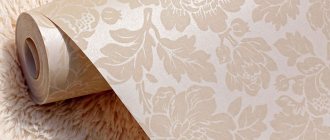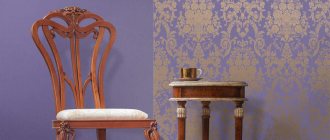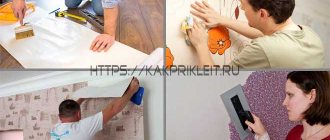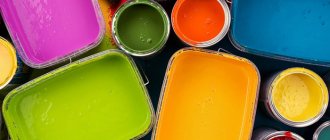Types of vinyl wallpaper and the possibility of painting them
To successfully paint vinyl, you must first make sure that this type of wallpaper can be painted. Vinyl wallpaper has two layers, so it is more durable than regular wallpaper. Manufacturers produce them in three types:
- Kitchen ones consist of two layers of vinyl, they are durable, moisture-resistant, easy to clean, and often have a textured appearance (like tiles, tiles). They are glued in the kitchen or bathroom. Such wallpaper can be painted, but this is rarely done.
- Foamed vinyl is basically the same vinyl, with a top layer of PVC applied by spraying. It is soft, textured, and suitable for uneven walls. This type of wallpaper holds up well to painting; it can be painted up to 10 times (but usually 5-8).
- Flat vinyl sheets have a traditional bottom vinyl layer and a thin top layer; here other materials (most often silk fibers) are added to polyvinyl chloride. This wallpaper has a textured, bright, fine and beautiful surface. Coloring them is possible, but will lead to a smoothing of the pattern.
There are also options for vinyl wallpaper on a non-woven basis, which can also be painted.
If you paint simple paper wallpaper, it can get wet and simply tear. Some vinyl wallpapers also have a paper backing, so if you plan to paint the wallpaper, then when buying it, pay attention to the inscription “For painting”. If it is not there, it is better not to risk it.
Typically, wallpaper to be painted is completely white or has soft pastel colors - this will make the color look better on it after painting. This material costs less compared to analogues, because painting non-woven wallpaper with your own hands will require the cost of paint.
Typically, such rolls are wide; when gluing, there will be fewer joints, but gluing them is more difficult.
What else can be done - 3 interesting techniques
Many owners are often interested in the question: “Is it possible to paint ordinary wallpaper using non-standard techniques?” Indeed, there are various painting methods used by professional installers, but this does not mean that they cannot be used at home.
Partial painting involves painting the surface with a roller, after which, without waiting for the vinyl to soak, the paint is wiped off with a damp sponge
Alternative dyeing methods are possible due to the positive qualities of non-woven vinyl materials. The top layer of such cladding is dense vinyl, almost without pores, which slows down the process of paint impregnation, but does not stop it. Long-term absorption ensures the highest quality fixation of pigments in vinyl, that is, the dye after repair can no longer be erased or washed off. Non-woven fabric, on the contrary, absorbs moisture well, due to which it quickly becomes colored, but retains pigments less well.
These features of the material made it possible to use several interesting paint application techniques:
- Partial coloring. This technique involves painting the surface with a roller, after which, without waiting for the vinyl to soak, the paint is wiped off with a damp sponge. As a result, the vinyl layer is painted, but the non-woven base is not. This gives the walls a deep, voluminous appearance, as the initial color of the coating shows through a little through the applied layer of paint.
- Coloring the non-woven layer. This technique involves painting the inner layer of the material before gluing it to the walls. The roll is cut into pieces of the required size, after which paint is applied to their reverse side with a roller. Gluing is carried out after the paint has completely dried. The effect of this staining method is similar to that described above.
- Use multiple colors. The method involves preliminary selection of the main and additional colors of the dye. After pasting the walls, the surface is painted with a roller in one layer, and then the structural details are drawn in contrasting shades with a brush. This technique allows you to use almost any number of colors for interior decoration, but requires professional skills.
Alternative painting techniques can be overwhelming, but anyone can paint vinyl siding without them. To do this, you don’t need any expensive tools or special knowledge, the main thing is to choose the right materials and believe in yourself!
Choosing paint
Painting vinyl is easy, and there are several ways to paint it. To get started, you will need to do the following:
- choose a coloring method;
- decide on the color, type and type of paint;
- purchase the necessary materials and tools.
And only then can you start working on the wallpaper.
Painting technology
Painting vinyl wallpaper includes several basic steps:
Stages of painting vinyl wallpaper
The instructions for doing the work look like this:
| Illustrations | Description of actions |
Tools and materials:
| |
Surface preparation:
Let me remind you that the primer is applied in thin, even layers, with mandatory drying between layers. Under normal conditions, the primer dries in one and a half to two hours. | |
Paint preparation:
| |
Painting:
|
Beginners often wonder if they can put wallpaper on paint? If the paint is waterproof and does not peel off, then in principle you can glue it. But, it’s better to take the time and prepare the surface properly.
Here, in fact, are all the main nuances of painting vinyl wallpaper.
Coloring methods
So, we choose the method of coloring non-woven fabrics. There are four most famous ones - let's look at each of them.
Before gluing
With this method, strips of cut wallpaper are painted before sticking. First, measure the tape from the roll and cut it, then paint it and only after 1 hour glue it to the wall. This method will allow you to get a beautiful base and a convex pattern in a lighter tone. The inner foam side of the wallpaper absorbs paint better, and the bumps will be painted more. The result will be a drawing on a lighter base.
After pasting
With this method, the strips are glued and allowed to dry completely, and only then (no earlier than 3 days) they are painted. This method allows you to get a smooth surface. If you use a stencil on the wall (they are sold in hardware stores), you can apply an original design. For smaller designs, use a stencil on a roller.
With rubbing
With this method, the wallpaper is painted, as in the second option, and then wiped with a dry cloth. So the pattern on the canvas will be lighter. Here they use the feature of foamed PVC to be saturated with paint on the front side more slowly than the base. This kind of work will require two people: one to paint, the other to wipe. The process is labor intensive.
Selective drawing
Here, the main paint is first applied, and then using a brush and a different color, the design is highlighted on the canvas. This is a complex and lengthy process, but creative people can do it.
Which paint to choose
The variety of coloring agents is amazing, for this reason it can be difficult to decide what to paint the surface with. When choosing, it is important to take into account that the paint should not be harmful to health, that is, suitable for interior work. The following types of paints and varnishes are selected for coating a vinyl surface:
- Water-based ones are a suitable option, but during operation it will not be possible to clean them using the wet method; they will be erased. Better suited for children's room, bedroom and living room;
- Dispersive, water-based, when the coating dries, it is smooth and impermeable, preferably used on bathroom and kitchen walls;
- Acrylic, quick-drying, it can be washed, you can use cleaning agents when you need to apply different colors, you don’t have to worry about them mixing, universal;
- Latex, the cost of production is high, but they are durable, the coating is even, smooth, and can be used for old canvases. Can be used in any room.
When choosing, it is important to take into account that the paint should not be harmful to health, that is, suitable for interior work.
There are also specialized paints for wallpaper; as a standard, they are sold in a basic white color; color is used to obtain the required shade. Mixing with the color should be done gradually, so as not to overdo it in brightness. Different effects can be created - matte, glossy, semi-glossy.
After obtaining the desired shade, it is tested on the wall, and the result is assessed only after drying. They also look at color under different types of lighting - natural and artificial.
Mixing with the color should be done gradually, so as not to overdo it in brightness.
Features of paint selection
If you have decided on the type of painting, proceed to choosing the main thing - the paint itself. First you need to choose the type of paint. It should be water-based - not oil-based. Paint for vinyl wallpaper is acrylic (best), latex, dispersion or water-based. Craftsmen prefer latex-based acrylic. What is important is its resistance to sunlight, detergents, fading, as well as its strength, environmental friendliness and speed of drying.
Today in construction supermarkets you can find special paint for wallpaper. It can be immediately with the desired color, but more often it is white, with dye (color) added to it.
There are three main surface options:
- gloss (semi-gloss);
- matte (semi-matte);
- atlas.
If you need to paint a small or dark room, it is better to choose an option with a glossy surface, but be prepared for the smallest dirt to appear on it. Matte paint is suitable for large rooms; it is not so picky about stains and touches. Use semi-gloss in the kitchen, and satin surfaces look great absolutely everywhere.
Selecting the appropriate paint
Before you start painting, it would be logical to first choose a paint that suits your canvas. At the moment, water-based paints are very popular, and in the same quantity there are requests seeking an answer to the question of whether vinyl wallpaper can be painted with water-based paint. The unequivocal answer is yes. This coating will last a long time. The paint has good moisture resistance. In addition to this type, there are other types of paints.
- Satin. After painting the surface is smooth.
- Semi-gloss. Well suited for kitchens and bathrooms, also used for decorating children's rooms. If you choose this product, make sure to level the wall properly, otherwise any flaw will be visible.
- Gloss. Used for dark and “cool” rooms due to its ability to illuminate the room.
- Matte and semi-matte. Well suited for bedrooms, living rooms and any spacious rooms.
Preparing for work
Before you paint non-woven wallpaper, you need to choose the right paint. Calculate its quantity, dilute the required volume immediately. This will allow you to get a uniform color throughout the room, especially if you use color scheme.
Try a small amount of paint on the wall to see what shade you'll get. Please note that the final color will only appear after complete drying (after 3 days).
Buy and prepare materials and tools so as not to ruin all the work. For painting you will need:
- paint and container for work;
- roller (velor, sheepskin) or spray bottle;
- paint tray;
- brush;
- soft cloth (several pieces - if you choose the wipe option);
- masking tape;
- floor protection material (film, newspapers, paper);
- protective equipment: gloves, glasses.
If painting is carried out before pasting, then it is important to prepare the walls for wallpapering. Clean them of the old coating, repair cracks and other damage, prime the walls - do this work before painting the wallpaper so as not to stain the already painted canvases.
Before painting vinyl wallpaper already pasted on the walls, be sure to clean it of dust and dirt. After cleaning, degrease and wipe the cloths with a soft cotton cloth soaked in dishwashing detergent. Proceed with painting only after the panel has completely dried.
Tools and paint
Before painting, you need to stock up on tools and paint.
First of all, you need to decide on the color scheme and buy the required amount of paint - as much as is required to completely paint the walls of the room. The photo shows a variety of colors that you can mix and choose the desired color scheme.
Attention! It is better to take paint for vinyl wallpaper with a small reserve, since sometimes something will need to be corrected or painted during the process, for example, a corner.
For vinyl wallpaper, the best option is water-based acrylic or dispersion paint. They are:
- matte - best suited for large rooms;
- semi-matte or semi-gloss - used in bedrooms or children's rooms, looks good in the kitchen;
- glossy coatings are used in dark rooms, as they reflect light well;
- The satin effect option is suitable for all rooms.
Water-based paints adhere well, painting the entire surface in an even layer.
Tools for painting you will need:
- paint roller;
- paint tray;
- brushes for painting hard-to-reach places;
- a roller with a stencil, if you decide to apply some kind of pattern on top.
The required set of tools is clearly visible in the photo.
Basic rules for coloring
Proceed with painting only when the canvases are completely dry. Paint on water will wet the wallpaper again and make it heavy, so don’t complicate your work. This can also lead to damage to the design or even the entire canvas.
The order is as follows:
- Before starting work, cover the joints of the wallpaper with doorways and baseboards with masking tape. Cover the floor with protective film. All materials and tools should be nearby, at hand.
- Dilute enough paint to cover the entire amount of work, otherwise your walls will have a different shade.
- Paint the ceiling first and only then start painting the walls.
- Start painting the walls from the bottom and work your way up.
- If the work is carried out with a roller, then do not use foam rubber - it can ruin the texture. Paint over the places where the roller does not reach with a brush.
- Carry out the first painting in 2 layers. Paint the wallpaper once, let it dry for 1 hour, and then repeat the painting.
The paint should be of medium thickness. Thick paint will clog the relief of the design, which will lead to a reduction in the possible number of stains.
The color can only be assessed after complete drying. The gloss will appear in 3 days.
To the question whether it is possible to paint vinyl wallpaper on a paper base, the answer will be this: you can try, but it’s better not to. Even if they have been glued for a long time and have a very dense structure, they can become soggy, lose their pattern, peel off, swell or tear.
Useful tips
Painting wallpaper in stripes using masking tape
- Be sure to choose not ordinary, but special glue for heavy wallpaper. Only in this case can you be absolutely sure that the wallpaper will not lag behind the walls;
- Glue the strips end to end, be careful and careful. Do not forget that during the process of applying glue, the wallpaper stretches quite a lot. But when they dry, they take their original shape. That is why the strips should be glued to each other as close as possible. Keep in mind that it will be quite difficult to hide the gaps in the future;
- When choosing glue, be sure to pay attention to the description presented on the packaging. Give preference to a special type of adhesive composition that will prevent the growth of microbes;
- Glue the wallpaper that you intend to paint only on perfectly smooth walls;
- If this is your first time using vinyl wallpaper or you decide to try a new paint, experiment on a separate, small area. Then observe how the chosen paint shows itself on the wallpaper, and only after that paint the entire surface;
- Do not allow the paint to slide over the surface. In order to avoid this, you should carefully prime your vinyl wallpaper.
Thus, we hope that there are no unclear places left for you, and if there is anything, please contact our specialist!
A few little secrets
Masters give beginners useful tips that will help make your home aesthetically pleasing:
- If possible, try to paint non-woven wallpaper using a spray bottle. This will make the painting even and allow you to paint them more times (up to 8).
- When starting to paint, start working in areas behind the furniture. This will help hide mistakes that occurred due to inexperience.
- Choose only wide wallpaper for painting on the ceiling. Ceiling panels must be painted twice.
- Remember, you can only paint non-woven wallpaper for painting: foam vinyl or kitchen wallpaper.
Painting tools
You can’t do without a brush and a roller, and in addition to these basic tools, you will need stencils and various molds and patterns. The main pigment is applied with rollers and wide brushes, while medium and narrow brushes are used for more precise strokes. The solution is also applied using spray guns and spray guns. But a foam coat is usually not used. Stencils protect various areas from painting, revealing the necessary ones. For painting you will need a painting tray and tape, a soft rag, and protective equipment - a hat, special glasses and rubber gloves. Masking tape is used to insulate all joints between walls and baseboards, floors, window openings and doors. Oilcloth is used to protect furniture. Lay newspapers, paper or film on the floors. In corners and joints, the dye is applied with the smallest brush.
You may also need:
- paint stirrer (usually enough application agent);
- different pads;
- suede ball.
Advantages and disadvantages of painting wallpaper
If the manufacturer himself wrote “For painting” on the label, this suggests that painting is not only possible, but also completely harmless. Indeed, the ability to paint wallpaper provides a number of advantages:
- You can change the interior of a room without spending too much on it.
- This can be done quickly and with little labor.
- It is possible to change the interior more often than when re-pasting wallpaper.
- There is wide scope for creativity and imagination.
However, among all these possibilities there are also a number of problems, and the main one is that the wallpaper does not “breathe” under the paint. This leads to stagnation of moisture and the formation of fungus. Therefore, it is not recommended to glue such wallpaper in bedrooms and children's rooms. To fix the problem, you should buy special glue for wallpapering.
Painting vinyl wallpaper is easy. It will not take much time and will not require large material costs. However, you need to remember that only those types of wallpaper that have a dense top layer are painted: for the kitchen or with PVC foam. Paper-based wallpaper can deteriorate: peel, tear, or even fall off. Also, silk-screen printing (chintz) is not painted, since after painting it loses its original relief appearance.
Pros and cons of painting
For gluing, you do not need to carefully prepare the coating. Embossed wallpaper, for example, will hide imperfections and roughness. But for subsequent painting, wall treatment will be required. Ignoring this rule will lead to peeling and cracking. But at the same time, if residents want to change the decor and paint the wallpaper a different color, then the new solution will fit normally on the old coating. The dyes are made hypoallergenic and environmentally friendly. Not least because of this, people began to abandon wallpaper on an unnatural basis. But after the invention of canvases based on algae, bamboo, raffia, reed, paints with chemical compounds are already harmful in the sense that they “interrupt” the properties of the environmentally friendly coating. The way out of this situation is to paint only with natural pigments. A noticeable disadvantage of painting is expressed in the low resistance of surfaces to contamination. We are talking about fatty traces and stains.
Benefits of coloring:
- interior improvement;
- hiding wallpaper imperfections;
- wide choice of colors and the ability to change them.
Conclusion
As you can see, there is nothing complicated about painting wallpaper. The main thing is to choose the right composition and carry out the work in accordance with the recommendations. The video in this article will help you understand this topic even better.
Similar articles
- Paint on the walls: instructions for choosing what is best to paint, video and photos
If you are planning to carry out repairs and refresh the paint on the walls, you will inevitably face the problem of choosing the optimal composition for the job. In our time… - Paint for baths and saunas: how to paint walls inside and out, instructions, video and photos
A real bathhouse must be made of wood, which must be protected from various troubles from inside and outside the room. For this… - Beige wall paint: instructions on how to make, which ones to mix to get the color, video and photo
Beige color is considered a classic color when decorating interiors. At the same time, it is extremely versatile, as it can be combined with…
Preparing walls for gluing
If you need to paint newly hung wallpaper, it is important to take into account several nuances.
First of all, before gluing, the outer side of the wallpaper must be primed with a special compound, let it dry and after that proceed with gluing.
Depending on the type of wallpaper, they require different times for the glue to dry completely.
Paper-based vinyl wallpaper dries quite quickly. After 24-36 hours they can be painted.
Non-woven backing takes much longer to dry, so they need several days to dry completely. Sometimes the process can take place within a week. It all depends on the microclimate of the room.
Only after the vinyl wallpaper has completely dried can you start painting. Pay attention to the photo of the interior:
Is it possible to paint
Many home craftsmen are wondering whether vinyl wallpaper can be painted. In order for the work to bring a positive result, it is necessary to make sure that a certain type of canvas can be painted. There are three types of similar wallpapers on the market today.
The first ones are kitchen ones and contain two-layer vinyl. They are moisture resistant and durable, they are easy to clean, quite often they have a relief appearance and imitate tiles or tiles. Use this wallpaper to cover walls in the bathroom or kitchen. You can paint them, but this is not done so often.
Some features of vinyl
Typically, experts say that non-woven vinyl wallpaper can withstand up to ten stains. But in practice, the relief pattern is visible only up to the fifth time, so during subsequent painting you should pay attention only to the shade of the color. The texture of the drawing will be viewed much worse.
It is worth paying attention to the following factor: whether the wallpaper will be washed during use after painting. Based on this, the paint is selected.
In the photo - vinyl wallpaper on a non-woven basis in the kitchen:
When purchasing, you need to calculate the exact amount of paint for repair. It should be taken into account that non-woven vinyl wallpaper is often produced in longer rolls than regular standard ones. The width of the pieces also differs from simple paper ones.
But when buying vinyl wallpaper of this size, you need to take into account that there will be significantly less scraps, the number of joints will be reduced, which will undoubtedly give the room a more aesthetic appearance.
Covering walls with vinyl wallpaper for painting will not be difficult, but wide canvases are much more difficult to paste. And if when working with ordinary ones you can handle it alone, then another pair of hands is needed here.
Painting
By the way, you can apply paint to pasted wallpaper on the wall, or you can paint the inside of it before gluing it to emphasize the relief of the canvas.
The simplest and most understandable way to apply paint to wallpaper. After gluing, you simply paint the wallpaper, but do it carefully and calmly. Carefully paint the texture of the wallpaper.
Using a fur roller for work
The second method is somewhat more complicated. We need to paint the inside of the wallpaper and then, after drying, glue it to the wall. Paint will stick to the non-woven base better than to the vinyl decorative side, so you can paint the canvas quickly. The main thing here is to wait for the paint to dry completely before gluing the wallpaper to the wall.
Note that with the second painting method, the finished version of the walls will be somewhat lighter than the painted canvases, so it is necessary to make the color more saturated.
However, if you are not satisfied with the result of the work, you can always paint the vinyl wallpaper on top again.
It is best to paint the walls right away, without being distracted or stopping, then you are guaranteed to have them all the same color. In addition, the paint will not thicken with constant use and will be easy to apply to the wall.
It is obvious that painting the wall was successful
Use masking tape to create even margins and protect other items from paint materials. It leaves no traces behind and is easy to stick and peel off.
The technology for painting wallpaper is understandable, we take a roller and paint, but selecting paints is a more complicated task, and we would like to talk about this process in more detail.
Related article: Using cream curtains in the interior of rooms
Is it possible to paint regular wallpaper?
No matter how beautiful your favorite wallpaper is, sooner or later its color will fade or simply get boring. Agree, seeing the same design, shade, year after year - everything over time begins to make any person despondent. There is an urgent need to change something, but how can you change old wallpaper without extra expense and effort? To do this, they are painted. But the question is: is it even possible to paint a regular coating or are only materials specially designed for this suitable?
Traditional types of wall coverings include paper wallpaper. They can be found in almost every apartment. If you suddenly want to update them, but not buy new ones and spend days and nights gluing new roll materials, be careful. Experts say that it is better not to paint ordinary wallpaper. Double-layer, single-layer wallpaper - this type of wall covering can be damaged by paint. However, a well-organized process will refresh long-faded colors in your home. It is necessary to study the basic requirements.
You can only paint wallpaper if it is not seriously damaged. It is important that the material does not peel off from the wall; on the contrary, it must adhere tightly to it, otherwise there is no point in buying a coloring composition.
Special requirements are placed on the level of paint quality. Among its basic characteristics should be present:
- strength. Ordinary ones need to be protected from various mechanical damages;
- environmental friendliness. If the coloring mixture contains toxic elements, the paper coating may not survive such painting;
- durability. The paint should retain its color for a long time. It is equally important to protect the coating from the harmful effects of water - choose a composition that can cope with this.
You can paint the old coating, but this is done exclusively with water-based paint. This category includes latex coloring composition. What is advantageous about its use is its ability to strengthen even ordinary paper coating. They become durable and can withstand further exposure to water. Feel free to wash the wall covering after using this material. Acrylic composition with a latex base is another popular product. After painting with this material, a regular coating acquires texture and is less susceptible to corrosion. You can paint them with water-based acrylic paint. Then the room will not feel musty or steamy, and the composition itself will dry quickly. The most budget option is water-based emulsion. It has no smell, dries instantly, but does not differ in water-repellent properties.
Liquid wallpaper
Sooner or later, painting liquid wallpaper may also be necessary. Over time, stains and dirt appear on liquid wallpaper, which cannot always be removed. Painting is the best way out. Choose a high-quality coloring composition and get to work. The choice of shades is so diverse that you can safely experiment. Buy either ready-made paint, or a base and colorants: this way, you can independently create a beautiful shade of color for liquid wallpaper. Whether it will be bright and saturated or, on the contrary, muted, depends entirely on you.
Before you decide to paint liquid wallpaper, pay attention to one key nuance: this material is silky and very soft to the touch. But after painting liquid wallpaper, the texture features are lost, you get a monochromatic coating, and even quite hard. Water-based paint compositions are suitable: latex, acrylic, water-based, and also silicone. The latest type of paint appeared on the modern market of finishing materials relatively recently. After using it, you need to wash liquid wallpaper without any worries. However, the cost of such coverage is much higher.
Vinyl and non-woven wallpaper
Vinyl wallpaper is based on ordinary paper, but compared to a standard coating, this product has good water-repellent properties. Foamed vinyl is painted first. The non-woven fabric can also be painted; it is durable and can withstand mechanical stress. It is possible to paint such a coating several times: do not be afraid to undertake this procedure again, the non-woven wall covering will not be damaged by repeated painting.
To paint vinyl wallpaper, use a regular roller, and make a design with brushes. Don’t worry if you don’t have the talent for drawing: as an alternative to hand-made designs, purchased stencils are suitable, and here you can give free rein to your imagination. Use the following advice: start painting in inconspicuous places (behind cabinets, sofas). Polish your skills and go to the barricades.
Paper wallpaper
Almost any coloring composition is suitable for paper wallpaper. The main thing is not to use oily liquids. The optimal choice is water-based, acrylic, latex paint. The advantage of painting paper wallpaper lies in the fact that, if desired, you can mix coloring liquids, trying to achieve the desired shade. Choose a high-quality composition - and it will not emit terrible odors, dry quickly and will not leak. Remember: immediately before the procedure, you should apply a primer. It will prevent the wall covering from getting wet, and you can safely paint the surface. After finishing painting the walls, wait until the composition dries, and then, if necessary, apply a second coat.
What paint can you paint canvases with?
Types of paint for vinyl wallpaper
Any paint for non-woven wallpaper can be used for walls. The owner of the premises decides which one to choose.
According to light reflection, the material is:
- Matt.
- Glyantsev.
Transitional:
- Semi-gloss.
- Semi-matte.
- Satin.
You can paint:
- Buy ready-made, desired color.
- Choose white or any light color and make the desired shade with your own hands using a special dye - color.
Tip: First you need to try the paint on a small area of the canvas, let it dry and see the resulting coating and its color. When choosing a tone, you should take into account that the color of the paint in a can looks brighter and more saturated compared to the painted surface.
The following paints can be used to paint non-woven wallpaper:
- Water-based.
- Acrylic. These coatings are more preferable in terms of technical properties; their price is less than latex.
- Latex (see Latex paint: how to work with it).
Tip: When choosing paint, preference should be given to acrylic water-based emulsion. It can be washed, has sufficient wear resistance, and has a long service life. When purchasing a coating, you should pay attention to the corresponding mark on the can - not all water-dispersed paints can be washed.
Besides:
- The paint chosen is sufficiently liquid; it should not clog in the relief; this will lead to a minimum number of repaints in the future.
- For non-woven wallpaper, you need to purchase mixtures that do not contain solvents. Aggressive chemical compounds dissolve non-woven fabric, and the fabric can simply creep apart.
Non-woven wallpaper for painting. How to paint
